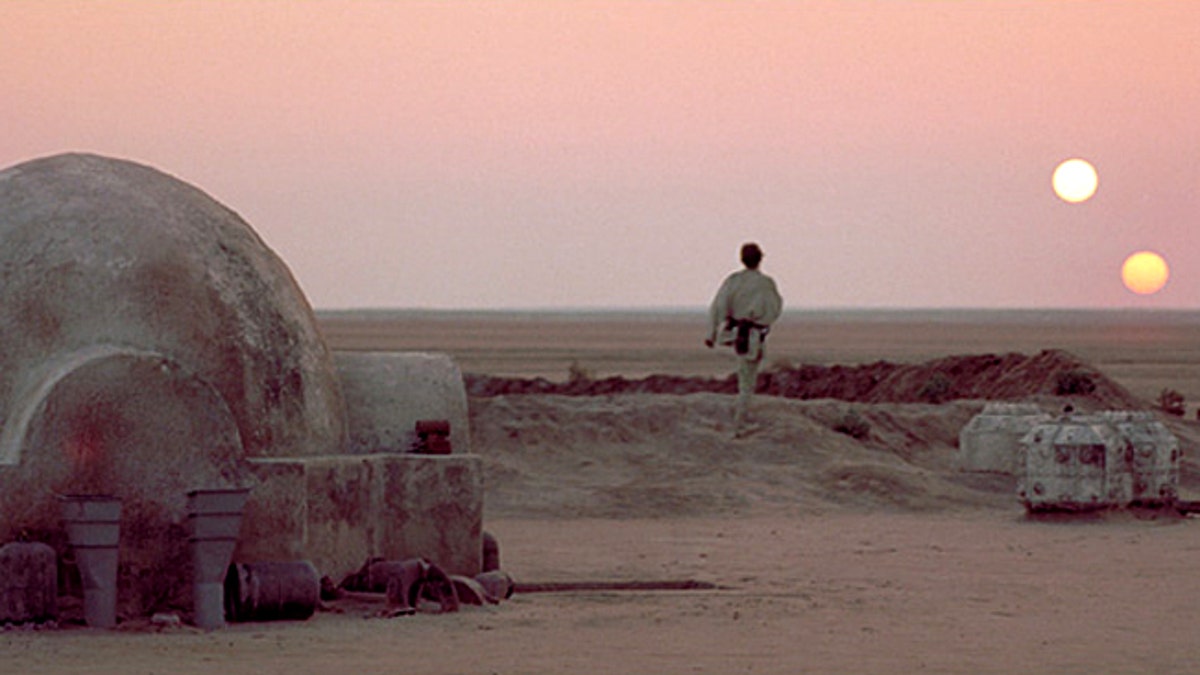
A young Luke Skywalker stares out over the dusty planet Tatooine in this film still from the movie, "Star Wars." (Lucasfilm)
Just how real were the worlds seen in Star Wars?
In a familiar scene from the famous first film, Luke Skywalker looks over barren and dusty Tatooine as the planet’s two suns set in the distance. Now a scientist from St. Andrews University in Scotland has studied what exactly life would be like on a planet with two suns -- more specifically, what plant life would be like.
In his latest work, Jack O’Malley-James, a theoretical astrobiologist, proposes that plants may appear black or grey if thriving on a planet spinning beneath two suns. O’Malley-James has spent years simulating the flora and fauna that would grow on an Earth-like planets orbiting two or even three stars. He is set to present his findings at the RAS National Astronomy Meeting in Llandudno, Wales on Tuesday, April 19.
"For plants living off a red dwarf [a star much dimmer than our sun], you would need to collect much more light from the star. So in order for a plant to absorb enough light, it would probably be much darker -- even black,” O’Malley-James told FoxNews.com.
Much of O’Malley-James’ research revolved around potential changes in photosynthesis -- the process by which plants gather light to convert into food. And just like the comings and goings of Superman’s abilities, the color of the suns would very much affect the photosynthesis process, and therefore the color of the plantlife.
“The temperature of a star determines its color and, hence, the color of light used for photosynthesis. Depending on the colors of their star-light, plants would evolve very differently,” O’Malley-James said.
To simulate most of his research, O’Malley-James essentially took Earth and placed it in a hypothetical system with two or more suns, keeping many of Earth’s conditions the same. Given this scenario, he predicted two major plant groups would ultimately form -- plants would either adapt to gather light from both suns or different forms of plants would develop. Though O’Malley-James said it’s much more likely for the latter to be true.
“If these two light sources were visible at different times of the year, it’s more likely you’d get two distinct groups of plants,” O’Malley-James told FoxNews.com. “One that uses light from one star and one that uses light from the other star. On Earth, these are called specialists, and it’s a much more evolutionarily stable strategy.”
In order for a binary star system to exist, planets within the system must revolve around these two stars in one of two ways. Either the stars are clustered together so that the planet orbits both at the same time; or the planet orbits one sun with the other so far away that it is unable to affect the planet’s orbit.
“It’s getting increasingly likely that we would find something like this,” O’Malley-James told FoxNews.com. “There are plenty of binary systems out there in the galaxy. They could theoretically have at least a few stable orbiting planets. It’s very much something that could be testable someday.”
After O’Malley-James presents his research, he’s eager to expand upon it, saying there is still much more work to be done.
“The next obvious step is to take these models and put more complicated physics into them and make them more realistic,” O’Malley-James told FoxNews.com. “Model them off of a real star system. There’s lots of work to refine these models and make more accurate predictions.”
“And of course to find one of these planets,” O’Malley-James added. “But that’s a bit farther off.”
